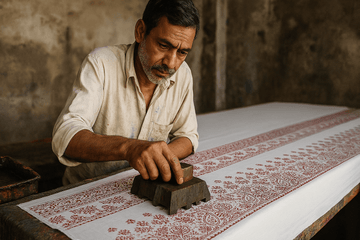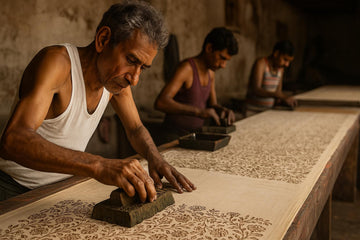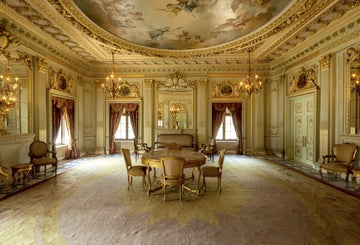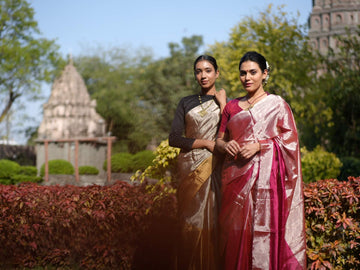The Soul of Print: The Timeless Tale of Bagru Hand-Block Printing
by Rahul Patwa on Apr 07, 2025

The Soul of Print: The Timeless Tale of Bagru Hand-Block Printing
Imagine this: the soft rustle of cotton fabric, the sharp scent of natural dyes, the rhythmic thump of wooden blocks hitting cloth — and hands, weathered yet graceful, moving with the precision of a dancer. Welcome to the timeless world of hand-block printing, where stories aren’t just told — they are imprinted.
This isn’t just a craft. It’s heritage, identity, sustainability, and slow fashion wrapped into one. And in the sleepy town of Bagru, just 30 kilometers from the pink city of Jaipur, a centuries-old art form still breathes, struggles, and blossoms — all at once.
Chapter 1: The Origins of Hand-Block Printing — A Global Story
Hand-block printing isn’t just an Indian story. It’s a global love affair that dates back over 2000 years. Evidence of block printing has been found in ancient China around 3rd century BCE. From there, the technique found its way to Egypt, Persia, and eventually to the Indian subcontinent — where it took on a life of its own.
India didn’t just adopt the technique. It transformed it.
From Gujarat’s Ajrakh to Rajasthan’s Sanganeri, and from Madhya Pradesh’s Bagh to West Bengal’s Baluchari — hand-block printing evolved with regional identities. But among all, one place created a signature so bold, so raw, and so real — it couldn’t be mistaken.
Chapter 2: Welcome to Bagru — The Beating Heart of Block Printing
Tucked away in Rajasthan’s dusty folds, Bagru is not a town you’d find on most travel itineraries. But it should be.
This is where the Chhipa community — whose name literally means “to print” — has kept hand-block printing alive for over 300 years. They migrated from Gujarat and settled here, drawn to the region’s water, soil, and natural mordants that are uniquely suited for dyeing and printing.
And they didn’t just bring their art — they made it a way of life.
Walk through Bagru’s narrow lanes and you’ll see a rare sight: open courtyards filled with long white fabrics laid out under the sun, artisans dyeing cloth in indigo vats, and wooden blocks stacked like sacred relics in dark, cool workshops.
Chapter 3: The Art Behind the Art — A Process Rooted in Nature
Here’s the surprise: every piece of Bagru fabric takes 15 to 20 meticulous steps. And most of these haven’t changed in centuries.
Let’s break it down:
1. Designing the Blocks
This is where the story begins — with hand-carved wooden blocks. Craftsmen, often from families of block-makers, carve intricate patterns into sheesham wood. These are the soul of Bagru — each block is a legacy, reused over generations.
Surprise fact: A single motif might require 3-4 different blocks — one for the outline, one for the fill, and others for accents.
2. Preparing the Fabric
The cloth is first washed in a solution of harad (myrobalan), which acts as a natural mordant. This ensures the fabric absorbs the dye evenly.
3. Dyeing and Printing
Using natural dyes — indigo, pomegranate rind, turmeric, madder root, and iron rust — artisans begin the slow, methodical process of printing. They dip the block into the dye tray, align it carefully, and press it down with a precise, firm smack.
This isn’t mechanical. It’s rhythm. It’s meditative.
4. Drying and Washing
After printing, the fabric is dried under the sun, washed in the river, dried again — sometimes even boiled with flowers or herbs to fix the color.
This entire process can take anywhere from 4 to 14 days — depending on the complexity of the design.
And all of it? Done by hand.
Chapter 4: Natural Colours — A Forgotten Palette
We’re so used to synthetic dyes that we’ve forgotten how alive natural colors can be.
In Bagru, colors are pulled from nature:
-
Black is made using fermented iron and jaggery.
-
Red comes from alizarin and madder root.
-
Yellow is extracted from turmeric or pomegranate skins.
-
Blue is dyed with indigo.
The results? Earthy, muted tones with a soul. They fade gracefully with time, unlike chemical dyes that crack and flake.
Surprise insight: These natural dyes are non-toxic, biodegradable, and skin-friendly — making Bagru prints not just beautiful, but better for your body and the planet.
Chapter 5: The Artisans — Keepers of the Flame
The average artisan in Bagru starts their day at dawn and works till sundown. Many of them are third- or fourth-generation printers, having inherited their skills, blocks, and stories from their forefathers.
And yet, many of them live hand-to-mouth.
Why?
Because fast fashion doesn’t wait. It demands quick, cheap, repeatable designs — a complete contradiction to everything Bagru stands for.
But things are changing.
Organizations, designers, and conscious consumers are beginning to recognize the value of handmade. Names like Anokhi, Raw Mango, FabIndia, and even international designers have collaborated with Bagru artisans to create limited edition, high-value collections.
Chapter 6: Slow Fashion & Sustainability — Not a Trend, But a Return
Slow fashion isn’t about trends. It’s about conscious choices.
When you buy Bagru-printed clothing, you’re choosing:
-
Minimal environmental impact.
-
Water-saving dye processes.
-
Ethical labor.
-
Long-lasting quality.
-
Zero plastic waste.
The irony? What we call “sustainable fashion” today is just what our ancestors did by default. Bagru’s model is proof that true sustainability lies in looking backward, not forward.
Chapter 7: The Global Market — Room to Grow
India’s textile export market was valued at USD 44 billion in 2022, and hand-block printing represents a niche, yet valuable slice of this pie.
While Bagru is still a small-scale operation, its potential is massive:
-
Handcrafted goods are seeing a surge in Western markets, especially post-COVID.
-
Etsy, Shopify, and Instagram are giving artisans and small businesses global visibility.
-
Cottagecore and artisanal fashion are no longer niche — they’re aspirational.
-
Tourists increasingly seek “authentic, handmade experiences” — making Bagru ripe for craft tourism.
And yet, less than 5% of Bagru’s production reaches international markets directly. The rest is sold through intermediaries — often with little credit to the artisans themselves.
Chapter 8: The Challenges — From Imitations to Infrastructure
While the art form is rich, the artisans face several headwinds:
-
Cheap Machine Imitations
Mass-printed fabrics mimic Bagru motifs and undercut prices — often selling at 1/10th the cost. -
Lack of Branding & Direct Market Access
Most artisans don’t have direct access to global buyers. Middlemen and bulk orders dominate. -
Dwindling Next Generation Interest
Many young artisans are leaving the craft for better-paying, stable jobs in cities. -
Infrastructure & Exposure
Workshops often lack basic amenities — clean water, ventilation, modern dyeing units. Plus, there's little exposure to design innovation or marketing.
Surprise fact: Despite contributing to a heritage art form, most Bagru artisans earn less than ₹12,000 ($150) a month.
Chapter 9: The Scope for Growth — Crafting the Future
So, how can we help this 300-year-old tradition not just survive — but thrive?
1. Direct-to-Consumer Platforms
Websites like Okhai, GoCoop, Maati, and Jaypore are bridging the gap between artisan and buyer. More such platforms can boost margins and recognition.
2. Geographical Indication (GI) Tags & Certifications
This protects Bagru prints from counterfeits and provides legal recognition.
3. Craft Tourism & Experience Centers
Imagine workshops in Bagru where tourists can learn block printing, stay with artisan families, and take home their own creations. It’s already begun — but needs scale.
4. Collaborations with Designers & Institutions
Design schools, sustainable fashion labels, and even tech platforms can co-create with artisans to bring in new energy.
5. Artisan Empowerment Through Storytelling
Each block, each motif, each artisan has a story. Brands that tell these stories are already winning hearts — and wallets.
Chapter 10: The Emotional Connect — Why It Matters
You’re not just buying a piece of fabric when you buy a Bagru-printed product.
You’re touching:
-
The fingerprints of a craftsman.
-
A design that’s hundreds of years old.
-
A tradition passed from father to son, mother to daughter.
-
A philosophy that says beauty comes from patience, imperfection, and nature.
In a world chasing the next big thing, Bagru quietly reminds us of what we’re losing: slowness, soul, sustainability.
Final Thoughts: What You Can Do
-
Buy consciously: Look for brands that work with Bagru artisans or sell certified hand-block prints.
-
Ask questions: Who made your clothes? How? Where?
-
Support local artisans: Even a small purchase can help.
-
Share the story: Every time you wear Bagru, you carry a story. Tell it.
And next time you hear the soft thud of a block meeting cloth, remember — it’s more than a sound. It’s a heartbeat. One that has echoed for centuries. One that deserves to be heard, felt, and cherished.




